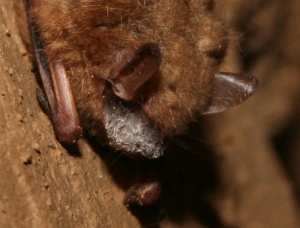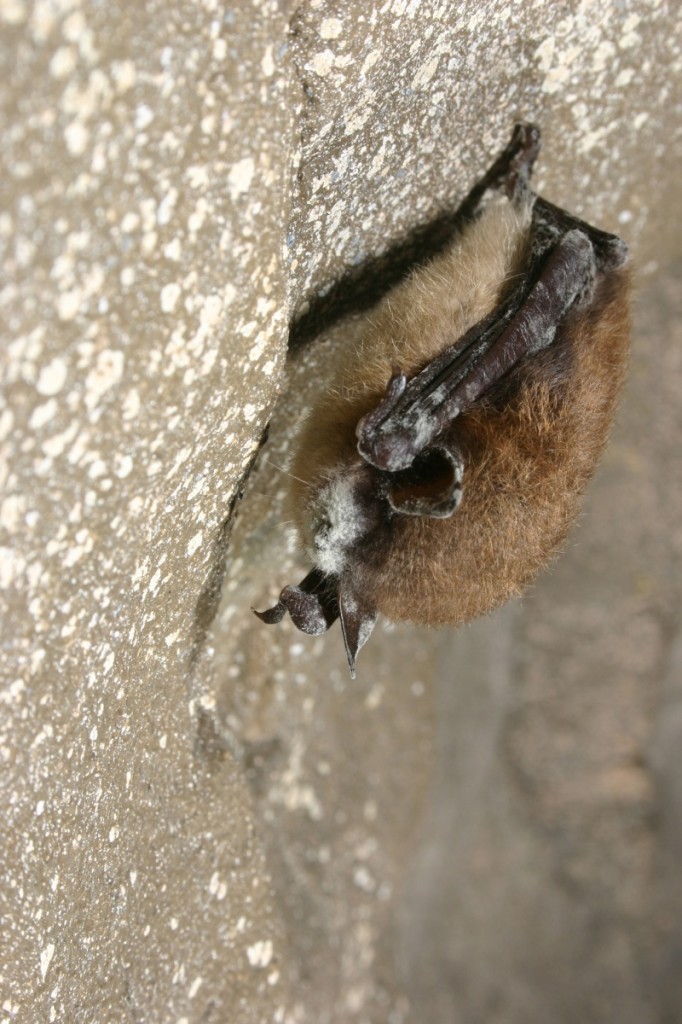n 2007, approximately 8,000 to 11,000 bats died in several New York caves, more than half of the wintering bat population in those caves. Cavers first noticed large numbers of dead bats around the mouth of one cave and reported it to wildlife officials in February 2006. Many of the dead bats had a white ring of fungus around their nose. Most affected hibernating bats in the region have white fungal growth on their ears, wings or nose. This condition is called White-nose Syndrome (WNS) and is associated with high bat mortality in the northeastern United States.
 Today, the fungus is estimated to have killed over a million hibernating bat species in more than 15 states and 2 Canadian provinces. Little brown bats, once a common bat in the area, are sustaining the largest number of deaths. A recent Department of Environmental Conservation survey shows a 93% decline of little brown bats in 23 caves at the epicenter of WNS. Currently five other hibernating bat species are affected by the fungus: big brown bat, northern myotis, tri-colored bat, eastern small-footed myotis and Indiana bat. The federally endangered Indiana bat has shown a decline of 53% in the epicenter caves. What is this fungus and how is it killing the bats?
Today, the fungus is estimated to have killed over a million hibernating bat species in more than 15 states and 2 Canadian provinces. Little brown bats, once a common bat in the area, are sustaining the largest number of deaths. A recent Department of Environmental Conservation survey shows a 93% decline of little brown bats in 23 caves at the epicenter of WNS. Currently five other hibernating bat species are affected by the fungus: big brown bat, northern myotis, tri-colored bat, eastern small-footed myotis and Indiana bat. The federally endangered Indiana bat has shown a decline of 53% in the epicenter caves. What is this fungus and how is it killing the bats?
 Thats what many bat scientists are asking themselves as well. We still dont have all of the answers. The white fungus found on the bats is a cold loving fungus now scientifically called Geomyces destructans. Dead bats with the white nose have exhausted their fat reserves and the fungus is thought to be a causing agent. Recent research has shown that WNS-affected bats are awaking as often as every 3-4 days as opposed to the normal every 10-20 days. Unfortunately, about 90% of the bats affected perish due to starvation.
Thats what many bat scientists are asking themselves as well. We still dont have all of the answers. The white fungus found on the bats is a cold loving fungus now scientifically called Geomyces destructans. Dead bats with the white nose have exhausted their fat reserves and the fungus is thought to be a causing agent. Recent research has shown that WNS-affected bats are awaking as often as every 3-4 days as opposed to the normal every 10-20 days. Unfortunately, about 90% of the bats affected perish due to starvation.
The bat conservation community is deeply concerned and involved in identifying the possible cause of the disease. The focus is to identify the cause of the outbreak and deaths, and to also learn how the fungus spreads. Recently WNS fungus has been found and identified in France. However it is yet unsure if the fungus came from Europe or has been transmitted from the U.S. Bat to bat transmission of WNS has been documented and a great amount of research is focusing on the mode of transmission and the cause of the fungus. Currently there is no cure for White Nose Syndrome. There is no information indicating that people have been affected after exposure to the white fungus.
What is OBC doing to Help?
The Organization for Bat Conservation is dedicated to protecting bats and their habitats. We have dedicated funds to support researching the fungus, providing roosting alternatives, and enhancing communication among researchers, agencies, environmental organizations, and the general public.
OBC donated funds toward an experimental freezer that is being used to study this new cold-loving fungus at the National Wildlife Health Center in Madison, Wisconsin.
 David S. Blehert from the center presented information at the North American Symposium on Bat Research that confirmed 90% of bats submitted from the WNS-positive sites exhibited the fungal infection. The fungus is a newly described species similar to Geomyces species. Fungal cultures grew optimally between 41 degree Fahrenheit (5 degree Celsius) and 50 degree Fahrenheit (10 degree Celsius).These temperatures are similar to the conditions in caves and mines that bats prefer to hibernate within the WNS-affected region. Blehert reported that the upper growth limit for the fungus is approximately 71 degree Fahrenheit (21 degree Celsius).
David S. Blehert from the center presented information at the North American Symposium on Bat Research that confirmed 90% of bats submitted from the WNS-positive sites exhibited the fungal infection. The fungus is a newly described species similar to Geomyces species. Fungal cultures grew optimally between 41 degree Fahrenheit (5 degree Celsius) and 50 degree Fahrenheit (10 degree Celsius).These temperatures are similar to the conditions in caves and mines that bats prefer to hibernate within the WNS-affected region. Blehert reported that the upper growth limit for the fungus is approximately 71 degree Fahrenheit (21 degree Celsius).
OBC donated 6 bat houses toward a joint study by the Indiana State University Center for Bat Research and Conservation and University of Winnipeg.
The researchers want to find out if providing bats with artificial thermal roost boxes within the WNS-affected caves could slow energy expenditure during the periodic arousals and prolong survival. They demonstrated the potential survival benefits using computer simulation and showed that localized thermal bat roosts reduce mortality from over 80% to less than 25%. A test site in Manitoba, Canada that is used by approximately 400 little brown bats was chosen. 6 (six) OBC bat houses were retrofitted with thermal heating elements and installed in 2009. The study will help determine the capability of bats to find and utilize the thermal boxes. The boxes will be tested in WNS-affected caves next winter.
OBC helps fund a project at Arkansas State University by Evan Lacy Pannkuk (ASU Ph.D. student).
The US fish and Wildlife service has produced a draft framework for managing white nose syndrome (WNS) that emphasizes the need for a basic understanding of WNS pathogenesis and host/disease ecology. This information is vital for researchers to develop a control mechanism that may stop further devastation from WNS. In order for a fungus to be pathogenic it must first attach to a host and obtain sufficient nutrients to grow. Our study will directly address these goals by monitoring optimal growth conditions of G. destructans, the fungus that causes WNS, and we will further determine how bats provide essential nutrients for fungal growth in delicate cave ecosystems. Knowledge on the lipid types present on bat hair will help determine how the fungus attaches to the hair and shed light on how the fungus breaks down bat tissues and feeds itself. Preliminary data already suggest that G. destructans (and its close relative G. pannorum) possess protein and lipid eating enzymes. This project will measure rates of digestion of proteins on bats by WNS. Arkansas State University has supplied lab space and equipment. The end product of the research conducted at Arkansas State will be a thorough understanding of how G. destructans is able to attach and grow on bats. If necessary biomolecules of the fungus can be blocked providing tools to slow or stop the spread of WNS is an exciting possibility.